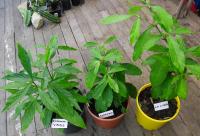i thought a thread on this could be usefull. i hope to expand this thread with more details, in given time.
first all three different viridis in one shot, all the plants are of similar age, but the moon aka la luna was a bit bigger when i recieved those beauties from tort.
Question
planthelper
i thought a thread on this could be usefull.

i hope to expand this thread with more details, in given time.
first all three different viridis in one shot, all the plants are of similar age, but the moon aka la luna was a bit bigger when i recieved those beauties from tort.

Edited by planthelpergrammar
Link to comment
Share on other sites
Top Posters For This Question
17
7
6
5
Popular Days
Jun 25
7
Feb 29
5
Feb 28
5
Jun 27
3
Top Posters For This Question
planthelper 17 posts
mauve 7 posts
rahli 6 posts
Zaka 5 posts
Popular Days
Jun 25 2011
7 posts
Feb 29 2012
5 posts
Feb 28 2012
5 posts
Jun 27 2011
3 posts
Popular Posts
whitewind
I can't pull this thread up but I saved the pics and feel justified in uploading them here. --- I create this topic in order to show that I'm growing six species and several to several years. I make i
planthelper
psychotria viridis, shipibo: psychotria viridis, moon: psychotria viridis, common: psychotria spp. nexus:
planthelper
i thought a thread on this could be usefull. i hope to expand this thread with more details, in given time. first all three different viridis in one shot, all the plants are of similar age, but the m
Posted Images
67 answers to this question
Recommended Posts
Join the conversation
You can post now and register later. If you have an account, sign in now to post with your account.